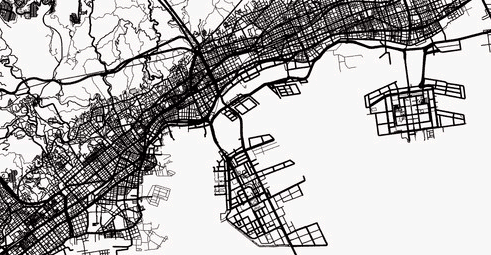
The 15-minute City
15-minutes of everything: Lessons from Kobe, Japan

Hari Srinivas Case Study Series C-035
Abstract:
Kobe, Japan, offers a compelling example of the 15-minute city model, not through intentional urban design but as a product of unique geographical constraints, post-disaster reconstruction, and efficient public transportation systems. Nestled between mountains and the sea, the city has developed a compact urban form that supports accessibility and livability. Mixed-use neighborhoods, vibrant community hubs around railway stations, and widespread local services including markets, healthcare, education, and recreational spaces contribute to Kobe's walkability and functional proximity.The city's redevelopment after the 1995 earthquake reinforced these features, making Kobe an organically evolved, highly accessible urban environment. This case study explores how Kobe exemplifies the principles of the 15-minute city and what other urban areas can learn from its structure and evolution. Keywords:
15-minute city, Urban accessibility, Kobe Japan, Compact city planning, Post-disaster reconstruction, Mixed-use development, Transit-oriented development, Walkable neighborhoods
Much like many cities in Japan, Kobe was never "planned" as a 15-minute city. But geographical and other circumstances have made it a good example of a 15-minute city.
Geographically, Kobe city is "squashed" between the Rokko mountains to the north, and the Pacific ocean to the south. It has three railway line running east-west through the city. This makes Kobe a a quintessential 15-minute city!Some of the features of Kobe include:
1. Compact City Layout: Kobe has a relatively compact city layout, with neighborhoods and amenities situated within close proximity to each other. This layout contributes to shorter travel distances and promotes walkability and cycling as viable modes of transportation.
The compactness is derived from its geographical limitations, as Kobe is located between the Rokko mountains to the north, and the Seto sea to the south.
There are a number of reasons why Kobe can be classified as a "15-minute" city, stemming from both organic and induced processes. These include its grographical location, earthquake risk, restricted land area, urbanization and other processes.2. Mixed-Use Neighborhoods: Many neighborhoods in Kobe feature mixed-use zoning, integrating residential, commercial, and recreational spaces within the same area. This mix allows residents to access essential services, shops, and amenities within a short distance from their homes.
Mixed use zooming was particularly enabled as a result of the recovery from the 1995 Kobe Earthquake, that necessitated extensive reconstruction of neighbourhoods that were destroyed by the earthquake and resulting fires.
3. Efficient Public Transportation: Kobe has a well-developed public transportation system, including buses and trains, which provides convenient access to different parts of the city. The availability of public transportation options supports residents in reaching their desired destinations within a 15-minute timeframe.
While railway stations are usually considered as simply a "access point" to trains and other public transport, ralway stations in Kobe (and elsewhere in Japa in general) are designed and developed more as mixed community hubs where a number of community and commerical activity are concentrated around a station.
Trains and subways in Kobe are operated by the national JR system, and also by private companies. Due to their easy access and convenience, railway stations function as community "hubs", where many facilities are located within walkable distance from railway/subway stations, including bus stations etc.
Railway stations therefore become the fulcrum around which community activities (and indeed broader urban development) happen - essentially also defining the pivot of a 15-minute city.
4. Local Markets and Shopping Streets: Kobe is known for its lively local markets and shopping streets. Areas like Motomachi and Sannomiya offer a range of shops, boutiques, supermarkets, and specialty stores, allowing residents to meet their shopping needs within a short walk or commute.
Railway stations are envisaged as a central location where a number of everyday tasks, including those related to work, can be undertaken within a 15-minute radius of a station not only highlights the 15-minute concept, but also adds to the broader convenience and adoption of public transport rather than private cars. A quick survey of railways stations found that tasks that are short and quick are ;located within 5-10 minutes of a station, while longer and slower internations lie in a 10-15 minutes radius.Note: Railway stations (including subways) in urban areas of Kobe are usually located between 500 and 1000 meters apart.
Distance walk Examples of activities 5-10 minutes convenience stores, supermarkets, fast-food, shops and other commercial/business establishments. 10-15 minutes by walk Clinics/hospitals, restaurants, schools, local government/ward offices, office complexes etc. Most of these shoping areas are arrayed around railway and subway stations, to facilitate easy access. While shorter, quick inetractions happen within walkable distance from stations (within 5-10 minutes), longer and slower interactions take place further from the stations (10-15 minutes). This pattern of development - of railway stations functioning as community hubs - is enabled due to the highly efficient time schedules of trains, well laid out train stations that facilitating easy access, safe and secure areas around stations, and quick/easy access to all parts of the city.
5. Recreational Spaces: The city offers various parks, waterfront promenades, and green spaces that are easily accessible to residents. Places like Meriken Park and Port Island Park provide opportunities for leisure, recreation, and relaxation within a short distance from residential areas.
Most neighbourhoods have smaller parks for children to play and adults to exercise - that in most cases also double as evacuation centers during a disaster (with water storage tanks, search-and-rescue equipment etc.)
A night photo of the area around JR Sumiyoshi in Kobe city clearly illustrates the concentration of activity around the station area, compared to areas further away.6. Healthcare Facilities: Kobe houses a number of medical clinics, hospitals, and healthcare centers distributed across the city. This distribution ensures that residents have access to healthcare services within their vicinity, enabling quick and convenient medical assistance.
Each city ward of Kobe has a designated large specialty hospital, with a number of smaller hospitals and clinics located close to railway and subway stations.
7. Educational Institutions: Kobe is home to numerous educational institutions, including schools, colleges, and universities. This concentration of educational facilities allows students and their families to have access to quality education within their local communities.
The city is divided into school districts that ensure that children do not have to walk more than 150 to 200 meters to access a school.
8. Cultural and Entertainment Venues: The city features a range of cultural and entertainment venues, such as museums, art galleries, theaters, and performance halls. These venues offer residents opportunities to engage in cultural activities and events without the need for extensive travel.
Kobe emitomises the idea of a 15-minute city, where residents can fulfill their daily needs, access essential services, and engage in various activities within a short distance from their residences. Regenerate response
|
|
 |
Return to The 15-minute City Contact: |





